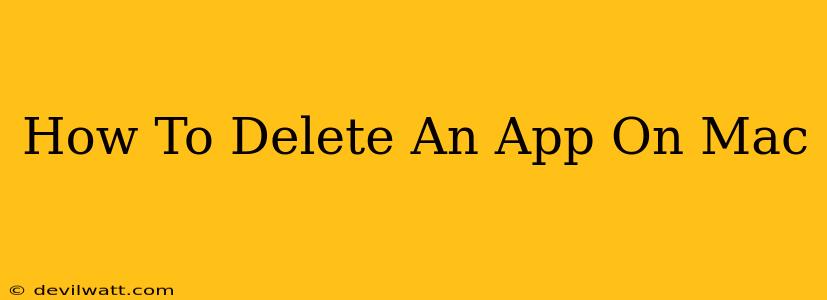Deleting apps on your Mac is easier than you might think. There are several methods, each with its own advantages depending on your needs and the type of app you're removing. This guide will walk you through each process, ensuring you completely uninstall unwanted applications and reclaim valuable storage space.
Method 1: The Simple Drag-and-Drop Method (For Most Apps)
This is the quickest and easiest way to delete most applications on your macOS.
- Locate the App: Find the app you want to delete in your Applications folder. This is usually found in your main hard drive's root directory.
- Drag and Drop: Click and hold the app icon, then drag it to the Trash icon in your Dock.
- Empty the Trash: Once the app is in the Trash, you need to empty it to permanently delete the app. Right-click (or Control-click) on the Trash icon in your Dock and select "Empty Trash." You may be prompted for your password.
Important Note: This method only deletes the main application file. Many apps store additional files, settings, and support files elsewhere on your system. This means residual data may remain, potentially consuming storage space. For a truly complete removal, consider the methods described below.
Method 2: Using Finder (For More Control)
Finder offers more granular control over the deletion process, allowing you to manually delete associated files and folders.
- Locate the App: Open Finder and navigate to the Applications folder.
- Identify Associated Files: Before deleting the main application file, it’s wise to search for and delete any related files or folders. These are often found in the
~/Libraryfolder (replace~with your username). Be cautious; deleting incorrect files could harm your system. - Delete the App: Once you've identified and (optionally) removed associated files, drag the main application file to the Trash, and then empty the Trash.
This method requires more technical expertise and caution. Be sure you know which files belong to the application before deleting them.
Method 3: Using App Cleaner (For Thorough Removal)
For a truly complete uninstall, consider using a dedicated uninstaller app like AppCleaner. These tools are designed to find and remove all associated files and settings related to a specific application, ensuring a clean removal.
Benefits of using App Cleaner:
- Thorough Removal: Removes all traces of the app, including hidden files and folders.
- Simplified Process: Streamlines the uninstall process, making it easier and faster.
- Reduced Risk of Errors: Minimizes the risk of accidentally deleting important system files.
Troubleshooting: App Won't Delete
If you encounter issues deleting an app (e.g., permission errors), try these steps:
- Restart your Mac: A simple restart can often resolve temporary issues that prevent deletion.
- Check Disk Permissions: Ensure you have the necessary permissions to delete the app.
- Boot into Safe Mode: Try deleting the app while booting your Mac into Safe Mode (hold Shift key during startup). This disables certain startup items that might interfere with the deletion process.
- Use a Third-Party Uninstaller: As mentioned earlier, an app uninstaller can effectively remove stubborn apps.
Conclusion: Choosing the Right Method
The best method for deleting an app on your Mac depends on your comfort level with your system and the extent of cleanup needed. For quick removal of most applications, the drag-and-drop method works well. For more thorough cleaning, or when dealing with stubborn apps, using Finder or a dedicated uninstaller is recommended. Remember to always exercise caution when deleting files, especially within the Library folder, to avoid damaging your system.

